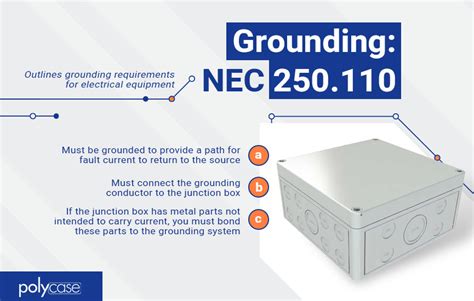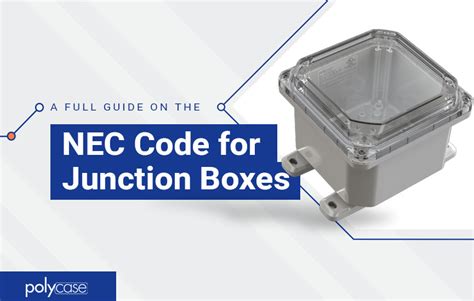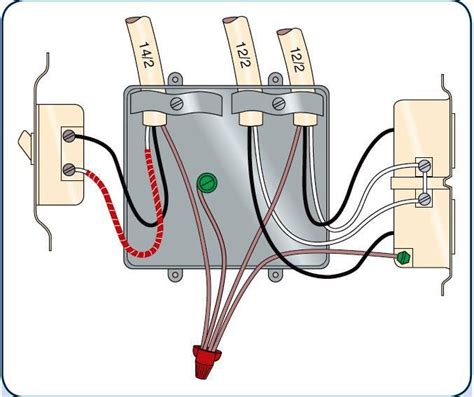can attic junction boxes be plastic As per the national electrical codes, these splices should be placed inside a covered electrical junction box made of plastic or metal. Wires should be placed inside a covered junction box because if the connecting wires become . Install the new box above it, and connect the two boxes with a short conduit nipple in a pair of knockouts that line up (or if there's a bit more space than shown, use an offset nipple if that helps to line things up.)What is the net electric flux through the box? A 1.0 cm × 1.0 cm × 1.0 cm box with its edges aligned with the xyz-axes is in the electric field E⃗ =(400x+100)i^N/C, where x is in meters. There are 2 steps to solve this one.
0 · nec junction box requirements
1 · nec compliant junction boxes
2 · junction box wiring requirements
3 · junction box wiring guidelines
4 · electrical junction box requirements
5 · electrical junction box installation
6 · attic junction box under insulation
7 · are junction boxes legal
In my opinion, a standing seam metal roof is the best metal roofing option for residential purposes. I always recommend a standing seam metal roof if you’re installing it over a heated residential space. I not only think it looks .
The other feature of metal boxes is they're designed to be used with blank covers, which are readily available. Plastic boxes are designed to . Is it safe to put a plastic junction box in the attic? Your local electrical code may allow you to place a junction box in the attic. Check with the permitting office before you do this. Plastic junction boxes can indeed be installed in attics, as both plastic and metal boxes are acceptable for use in these spaces. According to electrical experts, the key .As per the national electrical codes, these splices should be placed inside a covered electrical junction box made of plastic or metal. Wires should be placed inside a covered junction box because if the connecting wires become .
Plastic have the built-in nail vs needing screws to secure a metal box or stapling the box to a stud. Answers based on the National Electrical Code. Local amendments may apply. Installing a junction box in the attic has certain requirements that must be met to ensure safety and compliance with electrical codes. Here are some fundamental considerations: Accessibility : The location of the junction .
As far as I can tell plastic boxes are an inferior box once installed, but plastic are easier/faster to install than metal. For example plastic boxes often have built in nails and romex clamps, while metal boxes lack both. Plastic boxes are more commonly used with non-metallic sheathed cables and offer benefits such as lightweight construction and resistance to corrosion. Prepare for your junction box installation by taking the necessary . What would be a better choice if you were very fire-conscious (paranoid, perhaps) and wanted the most robust materials in your construction, metal or plastic boxes? I installed a .Just wondering if a metal or plastic box would be better for this. My assumption is that a metal box would be more protective since it would prevent (or at least offer a warning to) anyone trying to .
The other feature of metal boxes is they're designed to be used with blank covers, which are readily available. Plastic boxes are designed to have sockets and switches in them, and blank covers are oddities. That's why the last guy didn't use one: hard to find. Is it safe to put a plastic junction box in the attic? Your local electrical code may allow you to place a junction box in the attic. Check with the permitting office before you do this. Plastic junction boxes can indeed be installed in attics, as both plastic and metal boxes are acceptable for use in these spaces. According to electrical experts, the key considerations when installing junction boxes in attics are ensuring they are accessible, properly mounted, and covered, rather than the material they are made from.As per the national electrical codes, these splices should be placed inside a covered electrical junction box made of plastic or metal. Wires should be placed inside a covered junction box because if the connecting wires become overloaded or .
Plastic have the built-in nail vs needing screws to secure a metal box or stapling the box to a stud. Answers based on the National Electrical Code. Local amendments may apply.
nec junction box requirements

nec compliant junction boxes
Installing a junction box in the attic has certain requirements that must be met to ensure safety and compliance with electrical codes. Here are some fundamental considerations: Accessibility : The location of the junction box should be . As far as I can tell plastic boxes are an inferior box once installed, but plastic are easier/faster to install than metal. For example plastic boxes often have built in nails and romex clamps, while metal boxes lack both.

Plastic boxes are more commonly used with non-metallic sheathed cables and offer benefits such as lightweight construction and resistance to corrosion. Prepare for your junction box installation by taking the necessary safety precautions. Wear insulated gloves and safety glasses to protect yourself from potential shocks or debris.
What would be a better choice if you were very fire-conscious (paranoid, perhaps) and wanted the most robust materials in your construction, metal or plastic boxes? I installed a combination of metal and plastic boxes throughout the building, depending on the application. Just wondering if a metal or plastic box would be better for this. My assumption is that a metal box would be more protective since it would prevent (or at least offer a warning to) anyone trying to drill into the wall at that spot. The other feature of metal boxes is they're designed to be used with blank covers, which are readily available. Plastic boxes are designed to have sockets and switches in them, and blank covers are oddities. That's why the last guy didn't use one: hard to find.
Is it safe to put a plastic junction box in the attic? Your local electrical code may allow you to place a junction box in the attic. Check with the permitting office before you do this. Plastic junction boxes can indeed be installed in attics, as both plastic and metal boxes are acceptable for use in these spaces. According to electrical experts, the key considerations when installing junction boxes in attics are ensuring they are accessible, properly mounted, and covered, rather than the material they are made from.As per the national electrical codes, these splices should be placed inside a covered electrical junction box made of plastic or metal. Wires should be placed inside a covered junction box because if the connecting wires become overloaded or .
Plastic have the built-in nail vs needing screws to secure a metal box or stapling the box to a stud. Answers based on the National Electrical Code. Local amendments may apply. Installing a junction box in the attic has certain requirements that must be met to ensure safety and compliance with electrical codes. Here are some fundamental considerations: Accessibility : The location of the junction box should be . As far as I can tell plastic boxes are an inferior box once installed, but plastic are easier/faster to install than metal. For example plastic boxes often have built in nails and romex clamps, while metal boxes lack both.
Plastic boxes are more commonly used with non-metallic sheathed cables and offer benefits such as lightweight construction and resistance to corrosion. Prepare for your junction box installation by taking the necessary safety precautions. Wear insulated gloves and safety glasses to protect yourself from potential shocks or debris. What would be a better choice if you were very fire-conscious (paranoid, perhaps) and wanted the most robust materials in your construction, metal or plastic boxes? I installed a combination of metal and plastic boxes throughout the building, depending on the application.

junction box wiring requirements

sheet metal stamping process pdf
What’s the difference between outlet boxes and junction boxes? An outlet box and a junction box can be the same thing. A junction box is a standard electrical box that encloses wire splices and contains no device (like a receptacle).
can attic junction boxes be plastic|are junction boxes legal